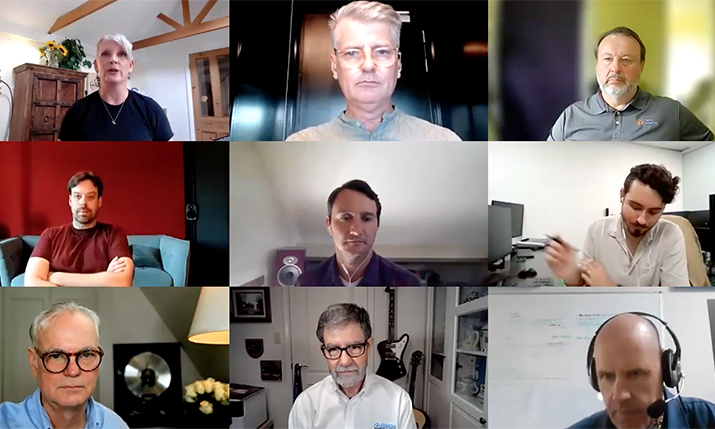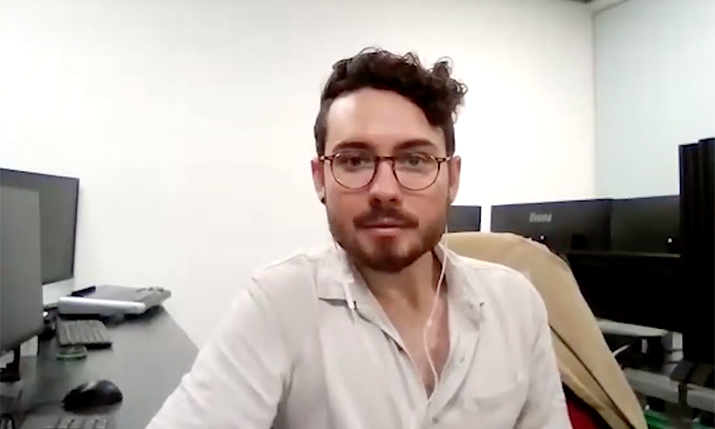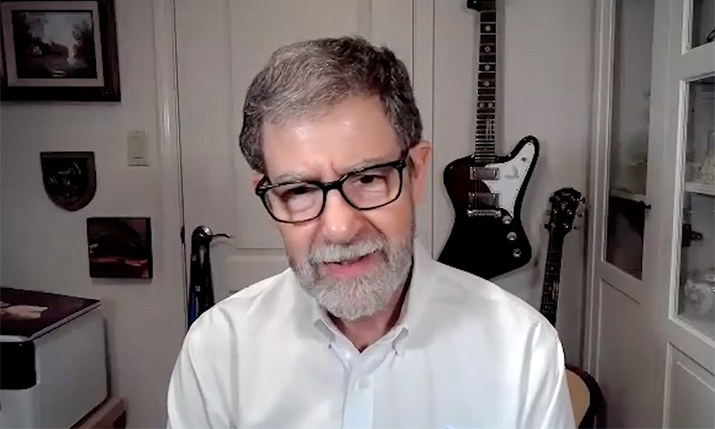Cloud comes of age in SVG Europe Audio’s latest live event

At the SVG Europe Audio Cloud Forum, [L-R top row] SVG Europe’s Heather McLean, Lama’s Ewan Cameron, Telos Alliance’s Martin Dyster, [middle row] Lama’s Jeroen Dieks, SSL’s Tom Knowles, EMG’s Lachlan Smith, [bottom row] chair Roger Charlesworth, ASG’s Dave van Hoy and Calrec’s Henry Goodman
But it really is not; it is developing at breakneck speed. In fact, it’s moving so fast that it is outpacing the audio standards committees.
“This point in time is unusual for our industry in that we are deploying technology before there are standards in a very rapid fashion,” said Dave van Hoy, president at Advanced Systems Group (ASG) in the US, speaking at SVG Europe Audio’s Cloud Audio Forum: Coming of Age, which was live online on 19 July. “It is the epitome of the internet, and internet years are like dog years on steroids. Things are evolving faster than the standards organisations can cope with.”
Watch the SVG Europe Audio Cloud Audio Forum: Coming of Age – Viewing is free but registration is required.
At last December’s SVG Europe Audio Summit in London, the cloud was on everybody’s mind, but not many broadcasters or manufacturers were confident enough to predict which direction the industry would move in.
Fast forward seven months, and that is no longer the case. In a wide-ranging panel that included end users, system integrators and manufacturers, everyone was on the same page. The technology is already there and in many cases is already being planned in, tested and used on air.

EMG’s cloud production developer, Lachlan Smith
Changes in attitude
While cloud might not solve everyone’s challenges all at once, no one expects it to. There was a unified spirit across the board to simplify audio workflows in the cloud and use it to create more content across more channels and for less money.
The first shift was a marked willingness from broadcasters to embrace these workflows. Broadcast audio has been done the same way for decades, but perceptions of how and where we mix these events have changed more recently. Remote production and the uptake of remote production hubs have revolutionised how live content is mixed; even the Premier League is now mixed in a remote hub, and production virtualisation is evolving in the same way.
Introducing the discussion was Lachlan Smith, cloud production developer at EMG, which already working with video in the cloud and is now starting to look at audio: “We’ve mostly been testing the video side of things, getting things up from a venue and remoting into the cloud,” he said.
“We’ve just started looking into cloud audio and an ideal solution would use the same cloud-based workflow to mix in the cloud. The tricky thing for audio is not just getting it up to the cloud but keeping sync between the audio and the cameras. We want to get it to the point where it looks no different to an operator whether the processing in in a control room or the cloud.”
EMG is not alone, as ASG’s van Hoy has been working with broadcasters on transitioning to the cloud since before the pandemic: “It’s amazing what panic will do for you – never waste a good crisis!” he said.
“At the beginning of the pandemic we were looking at the concept of moving some real time infrastructure into the cloud and as lockdown began, we began to spin some of these things up to enable production. About 90 days in we had a functional miniature Audio Control Room and we’ve been improving it ever since.
“We’re now putting it into the Google and AWS marketplace, and conceptually not much has changed. But what has changed is the number of vendors who are providing cloud services; we now have the ability to put large format consoles up there. Doing a few channels is not hard, but having 30 channels and keeping in sync is very new.”

Dave van Hoy, president, Advanced Systems Group
Accelerated development
Like in so many other areas of broadcasting, the pandemic pushed manufacturers like the Telos Alliance to accelerate development. Martin Dyster is its VP of business development and Telos Infinity product director. “The infinity IP intercom had been developed over virtual machines so we already had a lot of the work already done when we had requests to virtualise the whole platform. It meant we had working prototypes within three months, and partnerships with people like ASG have been one of the most important things.”
Similarly, the directors of product management at SSL and Calrec – Tom Knowles and Henry Goodman respectively – have been working with broadcasters on the New Heights cloud DSP mix engine, developed from SSL and Calrec’s parent group, Audiotonix.
Knowles said: “Customers were asking for a cloud solution and as a Group we looked at the best way to provide the user experience of a console with a virtualized audio engine behind it. We thought the best way was for SSL and Calrec to collaborate on that audio DSP together and provide a user interface which was specific to SSL and Calrec.”
Goodman added: “We wanted to provide the technology to do audio mixing at scale, which is where we believe the industry is going. Scale means different things to different people, but for us it’s not just about DSP channels. It’s about scale of the operating surface, the available outputs, the number of real-time operational resources for a full production environment.”
Like EMG’s Smith, Knowles says the aim is for it to be used in the same way as a traditional mixer, if a customer wants it to: “We want it to be like sitting in a gallery, and we’ve proven that this is possible from an operational point of view. It’s one of the first things we did as a POC, running a 5.1.4 bus in that environment.”
Lean and Mean Audio’s (LAMA), co-founder Ewan Cameron has also been working with broadcasters this last year through IBC’s Connect and Produce Anywhere Accelerator Project, the fruits of which will be introduced at IBC this year. In addition, its LAMA Mix is a cloud-based broadcast mixer which has been road tested on AWS with 128 channels and using off the shelf hardware controllers.
“We’re not aiming at the Superbowl with this,” says Cameron, “but there is such a huge market for everything else, and the challenge is to come up with viable software solutions which can utilise off-the-shelf hardware for these use cases.
“This technology is going to create new markets which couldn’t have been done economically before, so it’s an enabler. It creates new opportunities – it’s not that we are cannibalising what already exists. We’re actually creating a bigger pie.”
The size of that pie – indeed, the huge variety of numerous delicious pies – is the overriding message which everybody agreed on.
The future is hybrid
Audio in the cloud is never going to be the panacea which solves everything, and there will still be events which will work better to be on-site, or use on-prem or edge processing hardware. The future is not going to be one thing or another, but what cloud will do is encourage combinations of hybrid models which will flex depending on production needs, the panel concluded.
In this way the cloud model is just another DSP engine which broadcasters can access when they need it, and because it can quickly spin up and down, it could cater for a range of different production values and cost models. In addition, distributed DSP means that skilled operators don’t have to be shipped around and can be utilised on in-house hardware, irrespective of where the processing is.
Leading to growth
It opens the door to low cost access and resources to enable coverage of Tier 2 and Tier 3 events, and a growth in the overall televised sports market. Van Hoy is already seeing evidence of this: “We’re in the midst of a large installation for the PAC 12 network, and it’s a large on-prem installation with six consoles running of three cores, which is the same concept.
“Cloud just makes that easier; if we need we need more DSP it’s one more virtual machine. It makes that incredibly agile and outside of the Tier One events are the places where people will experiment more, and that’s also where they’re looking for the most cost savings.”
As the only sports broadcaster on the panel, Smith agreed: “Scalability means that eventually you should be able to use the same workflow on a really small production as a Tier 1 production. Broadcasters need to produce more content on more sports, including those with less funding where you need to scale things down. For bigger events you can go big with OBs and remote production, but we see the cloud enabling us to do cover more content within those smaller budgets.”
Other challenges, like timing, latency, automation and control, were all covered across the session, which can be watched online for free here (registration is required)

